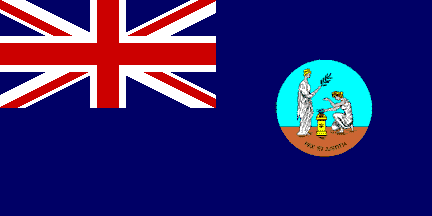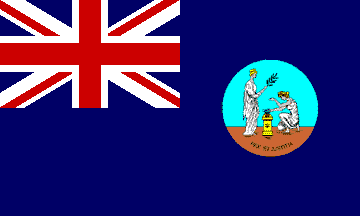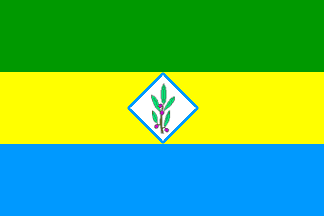
image by António Martins and Jaume Ollé, 24 Oct 1999

Last modified: 2013-11-05 by zoltán horváth
Keywords: saint vincent and the grenadines | pax et justitia | motto | colonial | badge | ensign | cotton |
Links: FOTW homepage |
search |
disclaimer and copyright |
write us |
mirrors
See also:

image by António Martins and
Jaume Ollé, 24 Oct 1999
On 27. October 1975 the British blue ensign with the
circular badge of the islands became the official
state flag and national flag on land and at sea (until
then the Union Jack had been the
state flag).
Ralf Stelter, 22 Oct 1998
The badge, as a flag defacement, was approved in
1877.
David Prothero, 10 Feb 2010

image by António Martins and
Jaume Ollé, 24 Oct 1999
The flag has the proportions of 3:5 on land and
1:2 at sea. On land this flag was the
“unofficial” National flag, to be used
for decorative and distiguishing
purposes (the official state flag was the
Union Jack).
The blue ensign
on land is not as unusual
as one might expect.
Ralf Stelter, 25 Jul 1999
On 1969 27th October, St Vincent became an Associated
State. Proposed flag not adopted.
Continued to use Blue Ensign with UJ
canton and 1877 badge.
David Prothero, 04 Aug 1999
col.gif)
click to enlarge
by Jaume Ollé, 16 Jun 2002
The badge, as a flag defacement, was approved in 1877,
but it was based upon the pictorial panel in the public seal which dated from
before 1839 — when it appeared in an anaglyptograph of Seals of
the Colonies of the British Empire.
David Prothero, 10 Feb 2010
According to Rudi Longueville’s Badges of the British
Commonwealth [lgv],
this badge was in use from 1907 to 1979 along with a
variant that had a slightly higher skyline and a larger central
“block” with what might be “clasped hands”
instead of the “eye”.
From 1889 to 1907, the badge was the same as this variant,
but with no symbol on the central block, no clothes on the
figure to the left, and no lettering. A variant of this had
"St.VINCENT" written circumferentially below the block.
David Prothero, 28 Jul 1997
The arms of Saint Vincent with similar escene were granted
29 November 1912 and probably then the old badge was
adopted officially.
Before 1900 (show in plates after 1889) was used a similar
badge, but with the words "Saint Vincent" in place of the motto.
The flag with badge (only minor variations) was in
use near 1900-1979. Later was not abolished but I don’t
know oficial use.
Jaume Ollé, 10 May 97
This post 1912 coat of arms was essentially the
1877 circular badge based on
the Seal of the Colony, inserted into an elaborate
frame with a scroll below and a cotton plant crest.
David Prothero, 04 Aug 1999
In the W. Smith’s small book there is a image of the
flag used (officially) from 1975, but similar variations
were used since late 19th
cent.: British blue duster with
circular shield from coat of arms: light blue, on
brown ground two women in classical cloths, right (heraldical)
standing and holding a palm branch, and left kneeling
before the yellow altar between them. Underneath the
motto: Pax et justitia.
Željko Heimer, 29 Jan 1996
It would seem that the pre-1907 form of the badge (and indeed any pre-1979
form) varied in too many details (clothing, colors, flames, emblem on the
“altar”, and writing). I’m even inclined to say that essencially
there was only one pre-1979 badge, which, as usual, suffered many different
renderings throughout the times, varying widely in both BR20 illustration,
actual manufactoring pratice and depiction in secondary sources.
António Martins, 20 Mar 2006
1877.gif)
image by David Prothero, 20 Mar 2006
The first badge of St Vincent was submitted to the Admiralty in 1877
[ADM 116/185] and illustrated in Arms & Badges of the Several Colonies
of Great Britain [hms81].
David Prothero, 20 Mar 2006
1907.gif)
image by David Prothero, 20 Mar 2006
In 1906, during the preparation of a new Admiralty Flag Book it was noted
that «Badge differs from seal in absence of
motto Pax et Justica, absence of clasped hands on altar, absence of plate in
hand of figure bending over flame, drapery different. Make badge more like
seal.» (Source: ADM 116/1063D, in National Archives). The revised
badge appeared in the 1907 Drawings of the Flags in Use at the Present Time
by Various Nations [hms07].
David Prothero, 20 Mar 2006

image by Roberto Breschi and
António Martins, 20 Mar 2006
After the project of statehood (1 June 1967) a flag green,
yellow, blue horizontal with lozengle white borderd blue
in the centre (and a flower in the white) was proposed but
never adopted.
Jaume Ollé, 10 May 97
The flag with horizontal stripes was never used, it only
was a proposal that some very fast writers took over
into their flag books!
Ralf Stelter, 22 Oct 1998
«St Vincent became an Associate State on 27 October 1969. A flag in the
colours of green, yellow and blue with a white diamond in the centre,
bordered in blue and charged with a sprig of leaves, was granted in 1967
but was never brought into use. Instead St Vincent retained the British
Blue Ensign with the circular flag badge in the fly. (…) when St Vincent
achieved independence on 27 October 1979, a completely new flag was
adopted, although the colours of green, yellow and blue and the sprig
of breadfruit were present in the design prepared for the Associate
State in 1967. (…) the breadfruit [was] first established in St Vincent
to provide a cheap foodstuff for the slave population (…)»
Santiago Dotor, 24 Nov 1999, quoting
[c2b81]
Why these three Caribbean flag, all from of 1967, are so similar?
Anticipating that St Vincent would become an Associated State the
College of Arms designed a new flag; green over yellow over blue with a
central badge of berries and leaves. They seem to have been trying to
create a family of flags for islands of the former
West Indian Federation.
David Prothero, 04 Aug 1999
The statehood took form in 1969 (27 October) and the
post stamps show a
flag blue with shield in the center, but this was never
adopted.
Jaume Ollé, 10 May 1997